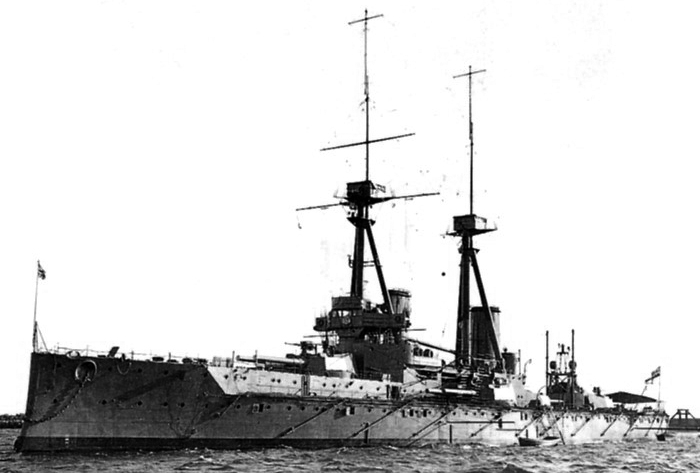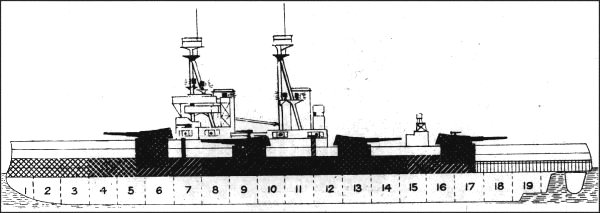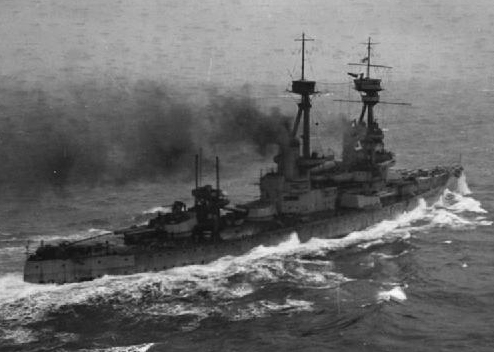Direct successors to the Dreadnought
By december 1906, after the famous battleship was launched, 1st lord of the Admiralty sir Jackie Fisher was so confident over the design, that three sister-ships were already ordered respectively on similar plans. They were laid down for Bellerophon at Portsmouth and in January and February 1907 for the Superb and the Temeraire, respectively in Elswick and Devonport shipyards. Utterly similar they however differed by some details, the first striking difference being the masts. They were launched between July and November 1907 and entered service between February and June 1909.
Design
The main singularity of these ships as stated was the use of two tripod military masts instead of one, the foremast being relocated in front of the first funnel to avoid the smoke plume to clog the vision of the forward observer. The second mast was located in front of the second funnel. The other major change was internal, as they received a complete internal protection without loss of speed, complete bulkheads running longitudinally through the ship whereas those of the Dreadnought only protected the magazines. Some sacrifices were done however, with belt armor decreased from 11 to 10 inches (254 mm) and reduced coal (therefore range).
Although their main armament was left unchanged in disposition their secondary 76mm QF guns were recognized as too weak to correctly deal with destroyers and replaced by Sixteen 4 in (102 mm) QF guns, which much longer range and twice the impact. This was supplemented with four 47 mm parade guns, firing white rounds, removed in 1914. A subdivision for better anti-torpedo protection was also added internally.
Active service
All three were active in 1915, when the 102 mm located on the roofs of the turrets, deemed too exposed, were removed and relocated in the superstructure. The masts have their upper extension shortened and they received a new radio system. Tow more secondary guns were also added, 102 and 76 mm AA. Heavy and unnecessary torpedo nets were removed, the bow torpedo tube Also, and projectors located on the platforms were also replaced by better protected, enclosed ones. In 1918 two turrets were fitted with launching platforms for a Sopwith Pup fighter and a Sopwith Strutter 1/1/2 used for advanced long range recognition. They were not recoverable and had to land on beaches if possible.
Links
Bellerophon class battleships on wikipedia
On dreadnoughtproject.org
Specs Conway’s all the world fighting ships 1906-1921.
HMS Dreadnought specifications |
|
| Dimensions | 160,3 x 25,2 x 8,3 m |
| Displacement | 18,800t, 22,102t FL |
| Crew | 773 |
| Propulsion | 2 screws, 2 Parsons turbines, 18 Babcock & W boilers 25-27,000 hp |
| Speed | 21.2-21.5 knots (39 km/h) |
| Range | 5,720 nmi (10,590 km) at 10 knots (19 km/h) |
| Armament | 10 x305 mm Mk V (5×2), 16 x102mm Mk VII guns, 4x 47mm saluting, 3 TT 457mm (sub) |
| Armor | Belt: 5–10 in (127–254 mm), Barbettes: 5–9 in (127–229 mm), Conning tower: 8–11 in (203–280 mm), Turrets: 11 in (280 mm), Deck: ½–4 in (15–102 mm). |
Gallery

HMS Bellerophon in 1909





.jpg)

_leading_the_fleet.jpg)
 Latest Facebook Entry -
Latest Facebook Entry -  X(Tweeter) Naval Encyclopedia's deck archive
X(Tweeter) Naval Encyclopedia's deck archive Instagram (@navalencyc)
Instagram (@navalencyc)





 French Navy
French Navy Royal Navy
Royal Navy Russian Navy
Russian Navy Armada Espanola
Armada Espanola Austrian Navy
Austrian Navy K.u.K. Kriegsmarine
K.u.K. Kriegsmarine Dansk Marine
Dansk Marine Nautiko Hellenon
Nautiko Hellenon Koninklije Marine 1870
Koninklije Marine 1870 Marinha do Brasil
Marinha do Brasil Osmanlı Donanması
Osmanlı Donanması Marina Do Peru
Marina Do Peru Marinha do Portugal
Marinha do Portugal Regia Marina 1870
Regia Marina 1870 Nihhon Kaigun 1870
Nihhon Kaigun 1870 Preußische Marine 1870
Preußische Marine 1870 Russkiy Flot 1870
Russkiy Flot 1870 Svenska marinen
Svenska marinen Søværnet
Søværnet Union Navy
Union Navy Confederate Navy
Confederate Navy Armada de Argentina
Armada de Argentina Imperial Chinese Navy
Imperial Chinese Navy Marinha do Portugal
Marinha do Portugal Mexico
Mexico Kaiserliche Marine
Kaiserliche Marine 1898 US Navy
1898 US Navy Sovietskiy Flot
Sovietskiy Flot Royal Canadian Navy
Royal Canadian Navy Royal Australian Navy
Royal Australian Navy RNZN Fleet
RNZN Fleet Chinese Navy 1937
Chinese Navy 1937 Kriegsmarine
Kriegsmarine Chilean Navy
Chilean Navy Danish Navy
Danish Navy Finnish Navy
Finnish Navy Hellenic Navy
Hellenic Navy Polish Navy
Polish Navy Romanian Navy
Romanian Navy Turkish Navy
Turkish Navy Royal Yugoslav Navy
Royal Yugoslav Navy Royal Thai Navy
Royal Thai Navy Minor Navies
Minor Navies Albania
Albania Austria
Austria Belgium
Belgium Columbia
Columbia Costa Rica
Costa Rica Cuba
Cuba Czechoslovakia
Czechoslovakia Dominican Republic
Dominican Republic Haiti
Haiti Hungary
Hungary Honduras
Honduras Estonia
Estonia Iceland
Iceland Eire
Eire Equador
Equador Iran
Iran Iraq
Iraq Latvia
Latvia Liberia
Liberia Lithuania
Lithuania Mandchukuo
Mandchukuo Morocco
Morocco Nicaragua
Nicaragua Persia
Persia San Salvador
San Salvador Sarawak
Sarawak Uruguay
Uruguay Venezuela
Venezuela Zanzibar
Zanzibar Warsaw Pact Navies
Warsaw Pact Navies Bulgaria
Bulgaria Hungary
Hungary

 Bundesmarine
Bundesmarine Dutch Navy
Dutch Navy Hellenic Navy
Hellenic Navy Marina Militare
Marina Militare Yugoslav Navy
Yugoslav Navy Chinese Navy
Chinese Navy Indian Navy
Indian Navy Indonesian Navy
Indonesian Navy JMSDF
JMSDF North Korean Navy
North Korean Navy Pakistani Navy
Pakistani Navy Philippines Navy
Philippines Navy ROKN
ROKN Rep. of Singapore Navy
Rep. of Singapore Navy Taiwanese Navy
Taiwanese Navy IDF Navy
IDF Navy Saudi Navy
Saudi Navy Royal New Zealand Navy
Royal New Zealand Navy Egyptian Navy
Egyptian Navy South African Navy
South African Navy






























 Ukrainian Navy
Ukrainian Navy dbodesign
dbodesign